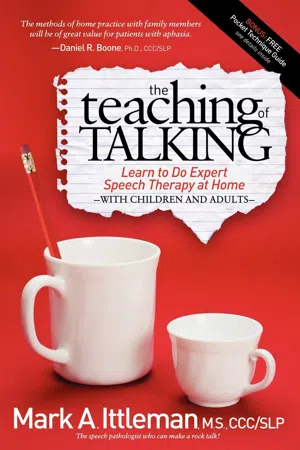
The Teaching of Talking
Learn to Do Expert Speech Therapy at Home With Children and Adults
- 206 pages
- English
- ePUB (mobile friendly)
- Available on iOS & Android
The Teaching of Talking
Learn to Do Expert Speech Therapy at Home With Children and Adults
About This Book
People with speaking difficulties are at the mercy of insurance companies who are determining how often and for how long speech therapy services should be delivered. It is also a disturbing reality that the likelihood for therapy frequency and length of care is contingent upon either the level of competence or comfort level of the speech-language pathologist or the financial policies of each institution. Often it has nothing to do with the severity or need for speech therapy. Our health care system is in no position to bankroll the long-term therapy that many people need who have moderate to profound speaking difficulties. The goal of Teaching of Talking is to make sure that any loved one, caregiver or speech-language pathologist is thoroughly knowledgeable in methods to help people improve talking since it is never known when the plug will be pulled on speech and language therapy services. Ittleman says: "I see hundreds of people with speech and language difficulties each year. By reading and applying The Teaching of Talking, you will have the confidence to help your client or loved one, no matter what the insurance company or institution does. By learning to do what is in Teaching of Talking you will be more self-sufficient and will not have to rely on anyone to provide your loved one with expert speech therapy.
Frequently asked questions
Information
Stimulation of Questions/Interrogatives

Other Types of Questions
(Interrogative) and How to Stimulate Them
Who Is It/That?
SM: | Do you want to know, Who is it/that? |
PCD: | (Nods) |
SM: | YES? |
PCD: | YES. |
SM: | Ask me: WHO IS IT? or WHO IS THAT? |
SM: | Do you want to know WHO ARE THEY? |
PCD: | (Nods) |
SM: | YES? |
PCD: | YES. |
SM: | Ask me: WHO ARE THEY? |
PCD: | WHO ARE THEY? |
What Are Those (Plural)?
SM: | Do you want to know, What are those? |
PCD: | (Nods) |
SM: | YES? |
PCD: | YES. |
SM: | Ask me: WHAT ARE THOSE? |
PCD: | WHAT ARE THOSE? |
SM: | Do you want to know, What is (the) time? |
PCD: | Mmmmmm. |
SM: | YES? |
PCD: | YES. |
SM: | Ask me: WHAT IS (THE) TIME? |
PCD: | WHAT IS TIME? |
SM: | Do you want to know what time it is? |
PCD: | Mmmmmm. |
SM: | YES? |
PCD: | YES. |
SM: | Ask me: WHAT TIME   |
When Is It/That?
SM: | Do you want to know, When is the show? |
PCD: | (Nods) |
SM: | YES? |
PCD: | YES. |
SM: | Ask me: WHEN IS (THE) SHOW? |
PCD: | WHEN IS SHOW? |
When Are ________ (Plural)?
SM: | Do you want to know, When are we going? |
PCD: | (Nods) |
SM: | YES? |
PCD: | YES. |
SM: | Ask me: WHEN ARE  |
PCD: | WHEN ARE  |
Where Is It/That?
Where Are______ (Plural)?
SM: | Do you want to know, Where are (the) keys? |
PCD: | (Nods) |
SM: | YES? |
PCD: | YES. |
SM: | Ask me: WHERE ARE (the) KEYS? |
PCD: | WHERE ARE KEYS? |
How Is It/That?
SM: | You want to know, how is it? |
PCD: | (Nods) |
SM: | YES? |
PCD: | YES. |
SM: | Ask me: HOW IS IT/THAT? |
PCD: | HOW IS IT/THAT? |
How Are _______ (You; Second Person or Third Person Plural)?
SM: | Do you want to know how I am? |
PCD: | (Nods) |
SM: | YES? |
PCD: | YES. |
SM: | Ask me: HOW ARE YOU? |
PCD: | HOW ARE YOU? |
Stimulating the Who Is It/That Question
SM: | Do you want to know who that is? |
PCD: | (Nods) |
SM: | YES? |
PCD: | YES. |
SM: | Can you ask: WHO IS  |
PCD: | WHO IS IT/THAT? |
SM: | Good. Can you tell me: WHO IS  |
PCD: | WHO IS IT/THAT? |
SM: | Do you want to know who they are? |
PCD: | (Nods) |
SM: | YES? |
PCD: | YES. |
SM: | Excellent. Ask me: WHO ARE THEY? |
PCD: | WHO ARE THEY? |
SM: | Who is she? |
SM: | Tell me: WHO IS SHE? |
PCD: | WHO IS SHE? |
SM: | IS SHE JUDY? |
PCD: | Oh. |
SM: | Can you tell me: SHE IS JUDY. |
PCD: | JUDY. |
SM: | Can you tell me: SHE IS JUDY. |
PCD: | SHE IS JUDY. |
Stimulating the What Is It Question
SM: | Do you want to know what it is? |
PCD: | (Nodding) |
SM: | YES? |
PCD: | YES. |
SM: | Can you say: WHAT IS IT? |
PCD: | W... |
Table of contents
- Cover
- Title Page
- Copyright Page
- Contents
- Note to the Reader
- Dedication
- Preface
- Acknowledgments
- Introduction
- The Teaching of Talking — A Conversational Approach to Helping the Person with a Mild to Profound Speech and Language Impairment Talk Better
- The Teaching of Talking — Helping the Person with Mild to Profound Speech and Language Impairment Talk Better
- The Ittle Principles of Talking
- Getting Down to the Actual Work
- Stimulation of Single-Word Speaking
- Stimulation of Phrases and Sentences
- Stimulation of Questions/Interrogatives
- The Tools of the Trade: What Every Speech-Language Pathologist and Speech Model Should Have at Their Disposal. 115
- The Concept of Massed Practice
- Your Approach to Mild Expressive Aphasia
- Speech as an Unconscious Process
- The Cure Versus Compensation and Adaptation
- Conclusion
- Epilogue
- About the Author
- Glossary of Terms
- Bibliography